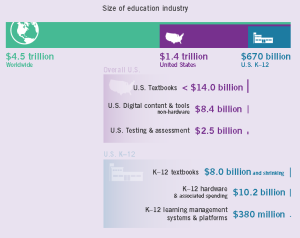The importance of scale in education analysis
In Keeping Pace 2015 we include some basic numbers about education that many people know, but are sometimes overlooked. These include the facts that the U.S. has about 100,000 public schools, 60 million students (depending on whom is counted), and 3 million teachers. (Click on images to enlarge.)
We also include some numbers that describe the size of the U.S. education market:
Why are these numbers important? Because K-12 education is so large that seemingly significant numbers often represent just a very small proportion of activity.
For example, we discuss state virtual school budgets, and point out that the 24 state virtual schools collectively are spending about $300 million per year. At first glance that sounds substantial, but in fact it represents less then two-tenths of one percent of state education budgets in those 24 states. Certainly $300 million is a large number, but it’s not large relative to those states’ total budgets.
Along similar lines, when Mark Zuckerberg and other donors pledged $200 million to transform the public school system in Newark NJ, on the surface that sounded like a game-changing amount of money. But the funds were to be spent over multiple years, and the district of about 40,000 students has an annual budget in the neighborhood of $1 billion. So the seemingly transformational donation amounted to about 4% of the district’s annual budget.
When discussing online learning—or any other part of education—we should keep in mind proportions and percentages, and not focus solely on the absolute numbers as they can be deceiving.



